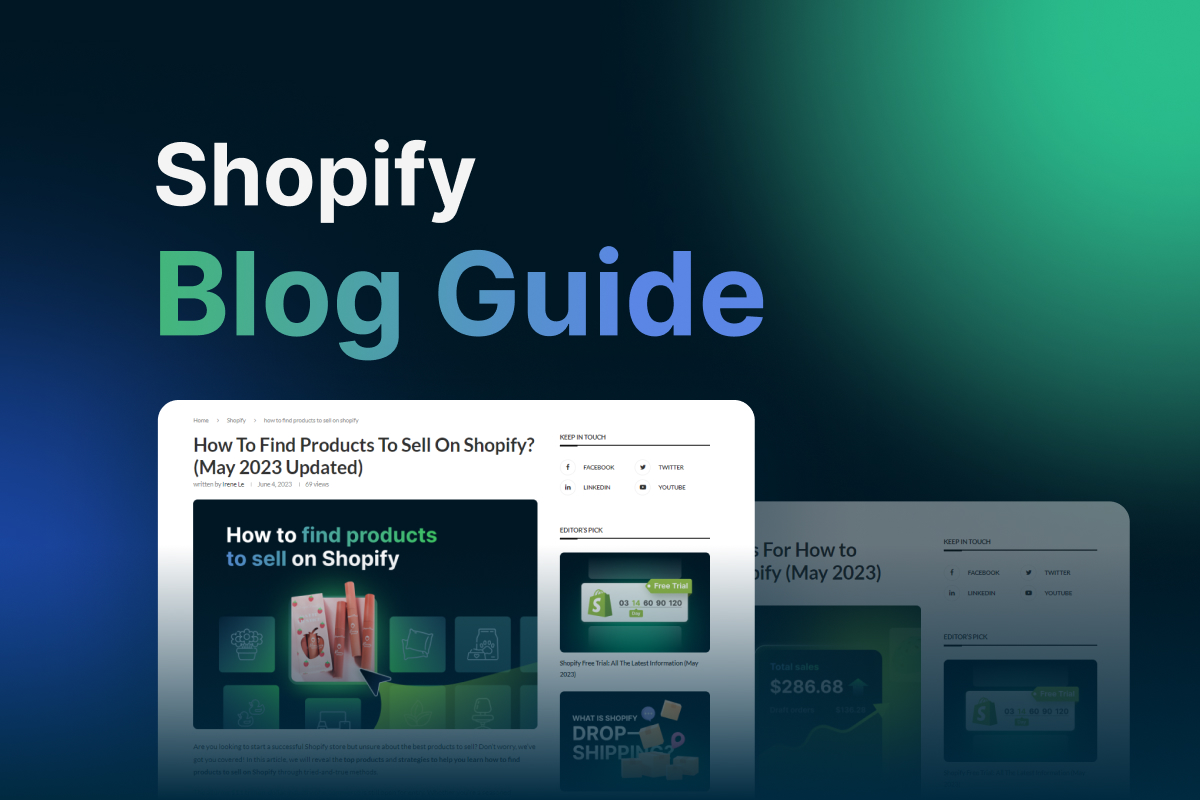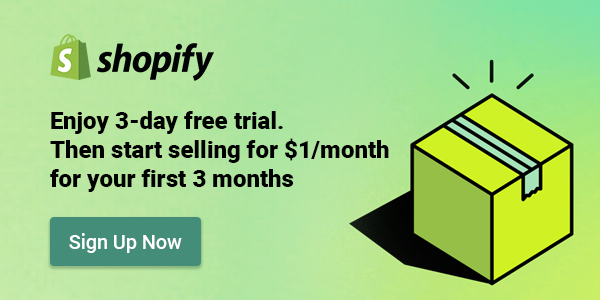Table of Contents
If you’re a Shopify seller, you might think blogging is not for you. After all, you’re busy enough with running your store, fulfilling orders, and marketing your products. Why bother with writing long posts that no one will read?
We’re here to tell you you’re missing out on a huge opportunity. Shopify blog is a great way to showcase your brand personality, share expertise, and build customer trust. It is also a powerful tool to drive more traffic, leads, and sales to your store.
Don’t believe us? According to HubSpot, merchants who blog regularly get 55% more website visitors and 67% more leads than those that don’t. And that’s not all. Blogging can also help you rank higher on Google, increase your social media presence, and generate more repeat purchases.
This article will show you how to start a Shopify blog and crush it online. You’ll learn everything from choosing a niche, creating a blog section, and getting people to read your blog.
Ready to get started? Let’s dive in!
What Is a Shopify Blog and Why Do You Need One ASAP?
You probably know what a blog is. It’s a website where you can publish content regularly, such as articles, videos, podcasts, or images. People blog for different reasons, such as to share their passion, express their opinions, educate their audience, or document their journey.
A Shopify blog is simply a blog that lives on your Shopify store. It’s connected to your products, collections, and checkout, so you can easily link to them from your blog posts. You can also make your blog look and work the way you want with different themes and apps.
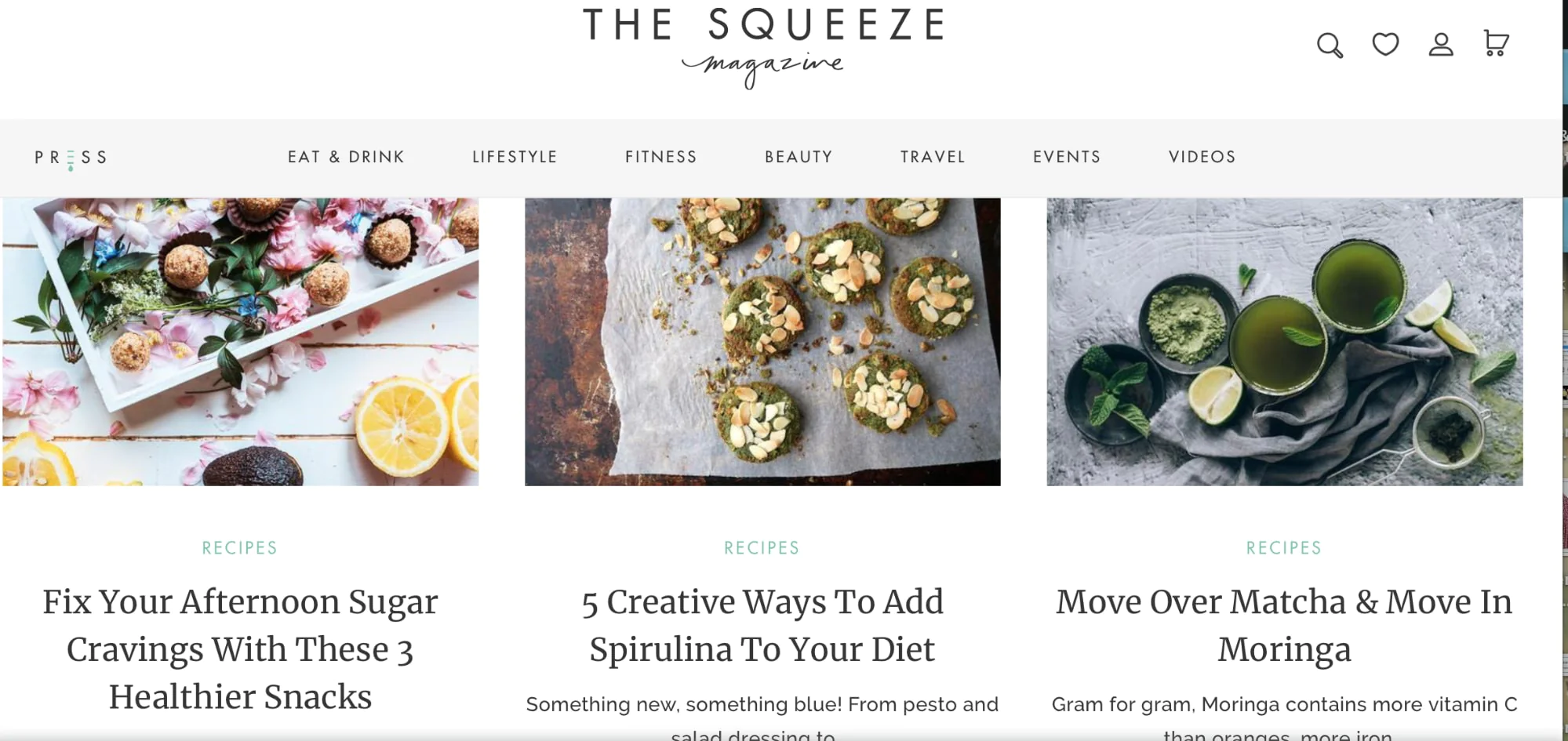
A sample of a nice Shopify blog on Lifestyle topics
A Shopify blog can help you skyrocket your eCommerce business in many ways. Here are some of the perks of having it:
- Boost your SEO: Blogging can help you climb up the search engine rankings by providing fresh and relevant content that matches the keywords your ideal customers are searching for. You can also use your blog to target long-tail keywords that are less crowded but more specific to your niche.
- Drive more traffic: Blogging can help you attract more eyeballs to your store by offering valuable information that solves their problems, answers their questions, or entertains them.
- Generate more leads: Blogging can help capture more leads by adding opt-in forms, pop-ups, or banners to your blog posts. You can also use your blog to offer lead magnets, such as eBooks, checklists, or coupons, that entice your readers to join your email list.
- Increase your sales: Blogging can help you convert more leads into buyers by building trust and credibility with your audience. You can also use your blog to showcase your products, highlight their features and benefits, share customer reviews and testimonials, or create urgency and scarcity with limited-time offers.
- Create loyal fans: Blogging can help you retain more customers by creating a loyal fan base that loves your brand. You can also use your blog to engage with customers, solicit feedback, answer comments, or run contests and giveaways.
As you can see, a Shopify blog is a powerful asset that can take your eCommerce business to the next level. If you don’t have one yet, you should start one ASAP!
How Much Money Do Shopify Bloggers Make?
Well, it depends.
The amount of money Shopify bloggers earn is not a fixed amount because it depends on various factors:
- Your niche: Some niches are more profitable than others because they are in higher demand, have less competition, or are more profitable. For example, a blog about luxury watches can make more money than a blog about socks.
- Your traffic: The more blog visitors you have, the more leads and sales you generate. You can increase your traffic by creating quality content, optimizing for SEO, and promoting your blog in various ways.
- Your way of making money: You can consider various ways, such as selling your products, promoting affiliates, displaying ads, sponsored articles, etc. Some ways are more lucrative than others, but they can be more difficult.
Blogging can be a profitable way to make money online. Millennial Money reported that bloggers who start from scratch can make $50,000 in their first year. Meanwhile, bloggers who have grown their traffic and subscribers can make over $100,000 in their second year.
Of course, actual results may vary. But it does mean blogging can be a fruitful income stream for your Shopify store.
How To Start a Shopify Blog With No Money As a Beginner
You might think that starting a Shopify blog requires a lot of cash, time, and skills. But that’s not true. You can start a Shopify blog with zero bucks as a newbie and still make it awesome.
How? By following these simple steps:
- Find a way for your blog to make money
- Pick a niche for your blog
- Add a blog section & create blog posts for your Shopify store
- Plan your publishing strategy
- Get loyal readers to your blogs
Let’s dive into each step!
Step 1: Find a way for your blog to make money
Before setting up your Shopify blog, you must find a way for your blog to make money. After all, you’re not blogging for fun. You’re blogging for business.
Remember this tip to pick out the best way to make money from your Shopify blog: start with the money part first, then the content part.
You should know what products or services you will sell and what affiliate programs you will join. Or what ads you will display and other ways you can make money from your blog. Because this will help you create content aligned with your monetization strategy. It will help you attract the right audience, provide value, and persuade them to buy from you.
Here are some of the most popular ways to make money via the Shopify blog:
- Sell your products: This is the most obvious way. You can use your blog to showcase your products, highlight their features and benefits, share customer reviews and testimonials, or create urgency and scarcity with limited-time offers.

A sample of a Shopify blog that sells IT Gadgets
- Display ads: You display ads on your blog and earn money for every click or impression you generate.
- Offer sponsored posts: You write a post about a product or service sponsored by a brand and earn money for promoting it.
- Accept donations: You ask your readers to support your blog by donating money or goods.
- Sell digital products: You sell digital products like eBooks, courses, webinars, or software on your blog and earn money for every download or purchase.
- Sell services: You sell services like consulting, coaching, designing, writing, or photography on your blog and earn money for every client you work with.
- Accept donations: You ask your readers to support your blog by donating money or goods.
- Promote affiliate products: You promote someone else’s products on your blog and earn a commission for every sale you generate.
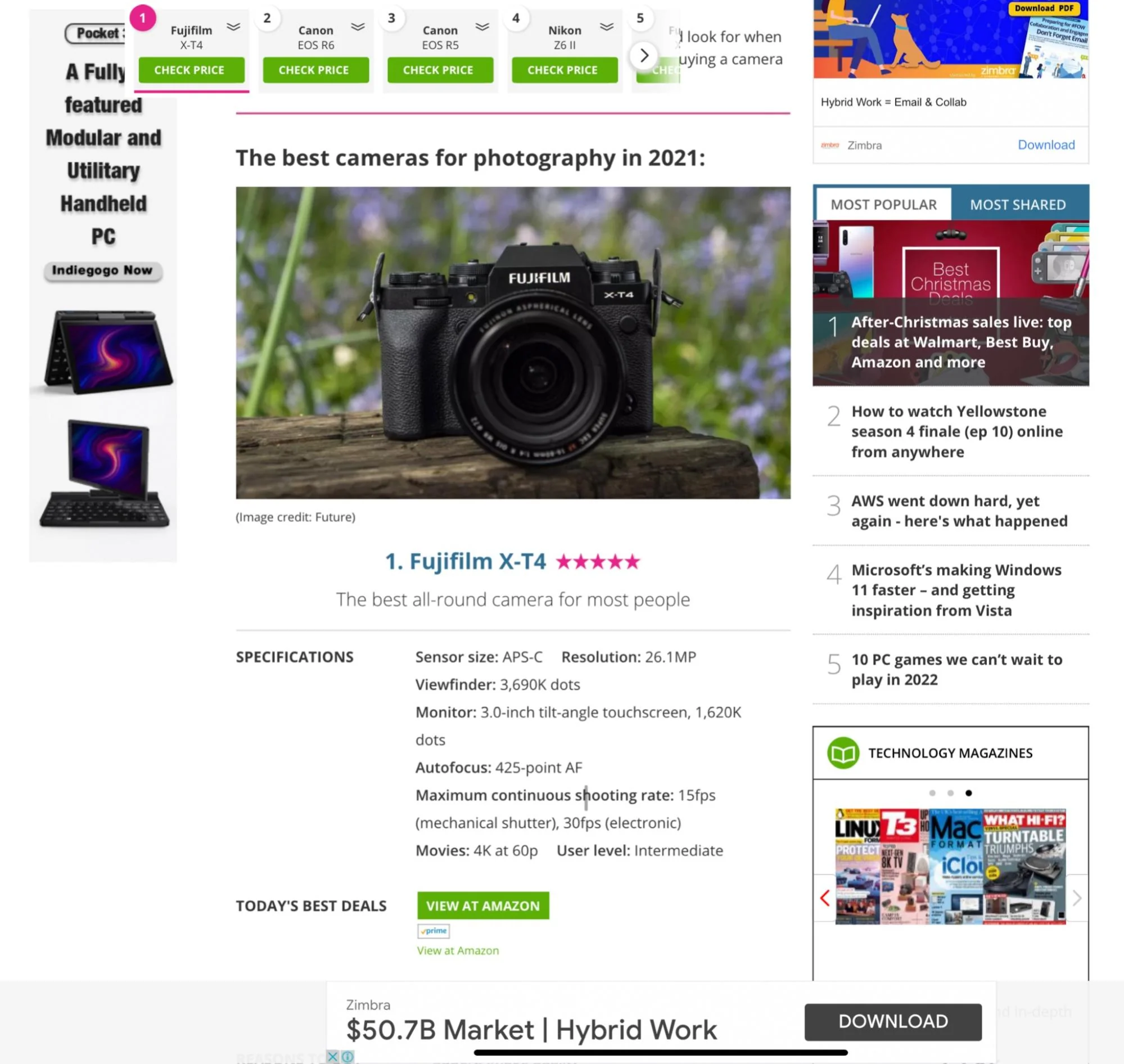
Amazon Affiliate is also a great way to make money on your Shopify blog
| 💡 Want to learn more ways to make money? Check out these articles: |
Step 2: Pick a niche for your blog
The Internet is full of content. It may seem hard to get noticed, but there are two ways you can win: by picking a specific niche to focus on, or by creating content that has something special that readers can’t easily find elsewhere.
Picking a niche is important because it helps you:
- Stand out from the crowd: Millions of Shopify blogs cover all kinds of topics. If you want to attract and retain readers, you need to differentiate yourself from the rest by choosing a niche that is unique and interesting.
- Target the right audience: By choosing a niche, you can narrow your audience and target the most likely to be interested in your products and content. This way, you can increase your conversion rate and customer loyalty.
- Become an authority: You can establish yourself as an expert and a leader by choosing a niche. This way, you can build trust and credibility with your audience and other influencers in your niche.
It’s important to pick a niche that is narrow but deep. To pick one, you should:
- Follow your passion: The best way to pick a niche is to follow your passion. Choose a topic you are passionate about, enjoy learning and writing about, and can sustain for a long time.
- Solve a problem: Another way to pick a niche is to solve a problem. Choose a topic that solves a problem that your audience has, that you have the skills and knowledge to solve, and that has enough demand and profitability. For example, if you know how to make money online, you can choose a make-money-online niche for your blog.
- Research the market: The final way to pick a niche is to research the market. Choose a topic with enough audience size, competition level, and monetization potential. You can use tools like Google Trends, Keyword Planner, or BuzzSumo to research the market for your niche.
By picking a niche for your blog, you can ensure you have a solid foundation for your Shopify blog.
Step 3: Add a Blog section & create blog posts for your Shopify store
Now you have all the awesome ideas, it’s time to add some spice to your Shopify store with a blog. This is where you will publish and manage your blog posts.
Creating a blog section for your Shopify store is easy and free. You don’t need any coding skills or extra tools. Just follow these steps:
1. Go to your Shopify admin dashboard and click Online Store > Themes. Then, click Customize.
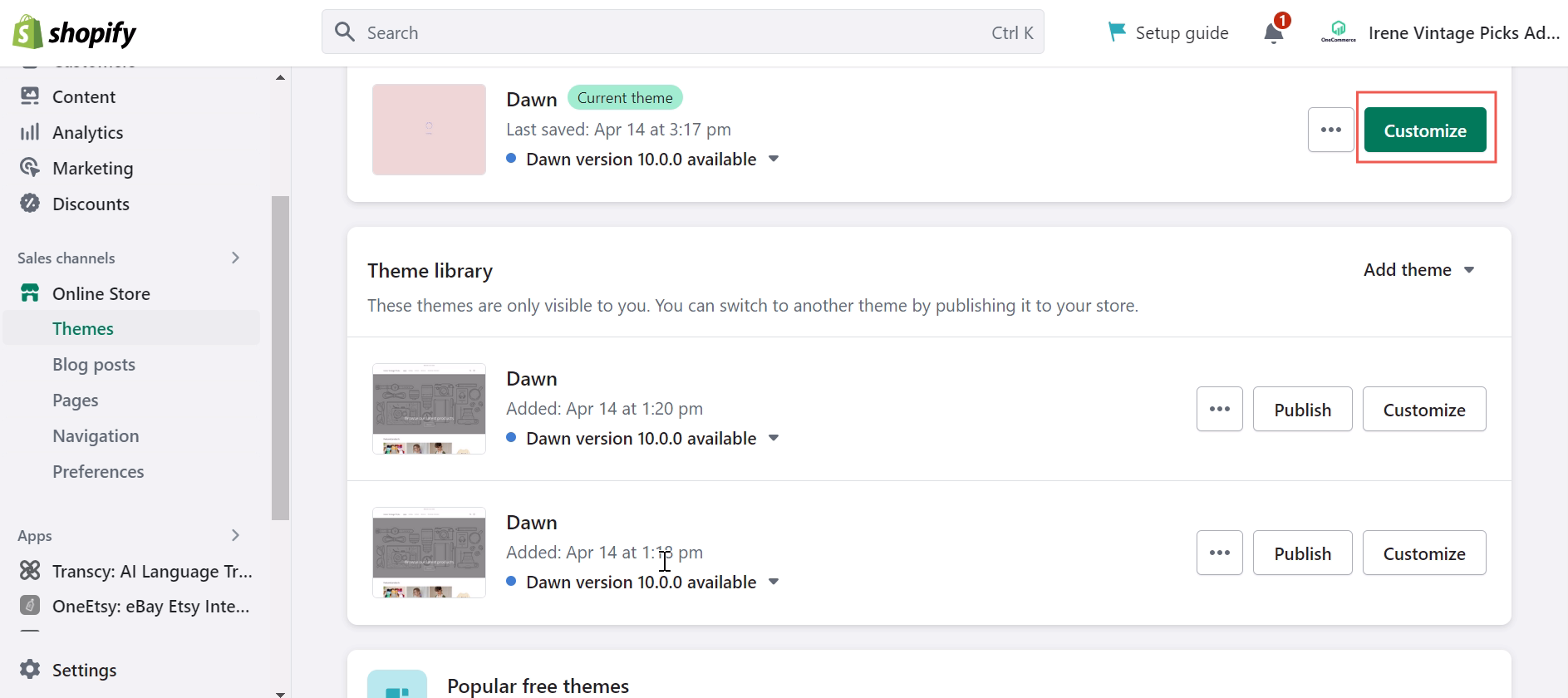
First, go to Themes and select Customize
2. Click on Add section > Blog posts.
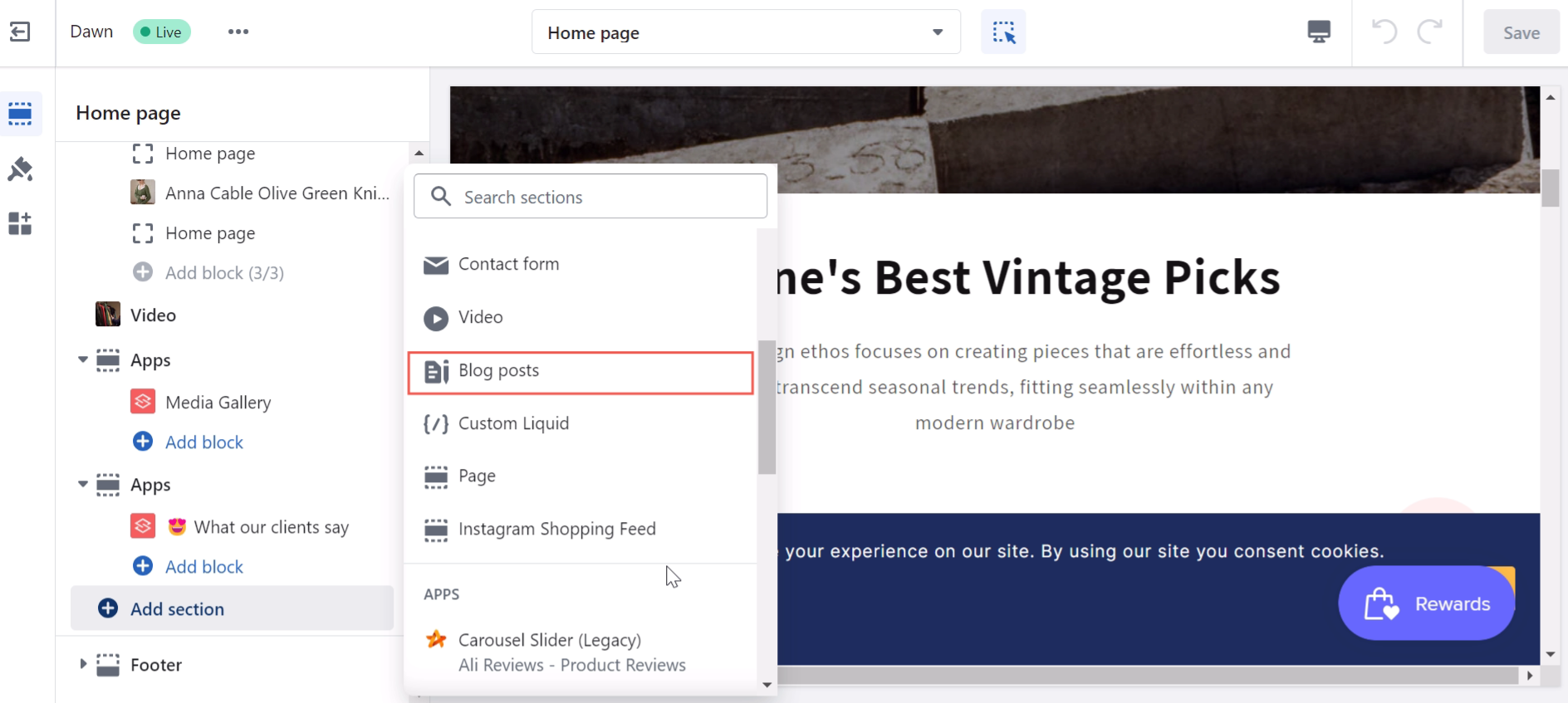
Click Add section and choose Blog posts
Awesome! You’ve just added the blog section to your store. Now, let’s create your first blog.
3. Return to your Shopify admin dashboard and click Online Store > Blog posts. Choose Create blog post.
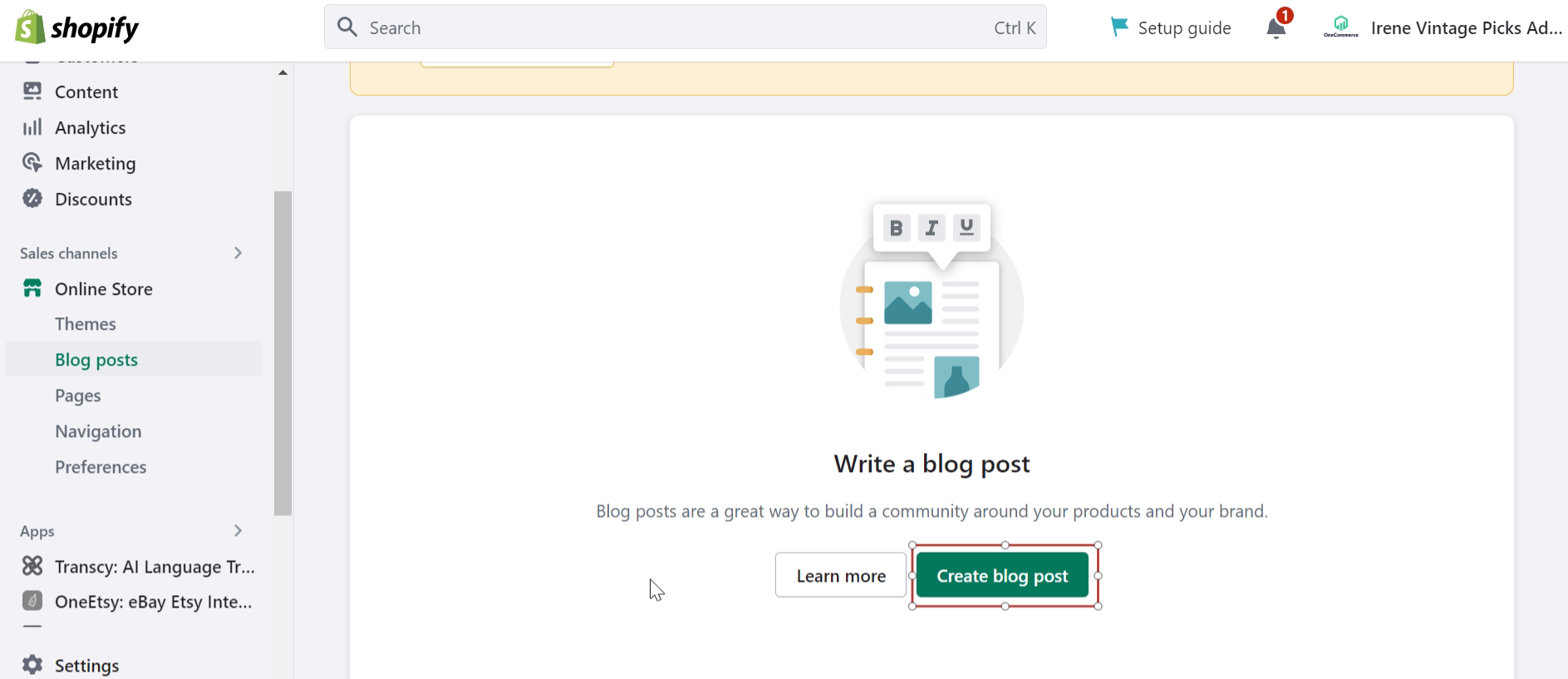
Go to Blog posts and choose Create blog post
4. Enter the name of your blog post (e.g., A COMPLETE GUIDE TO SHOPIFY BLOG) and the handle (e.g., shopify-blog). The handle is the URL of your blog (e.g., https://yourstore.com/blogs/shopify-blog).
You can now start writing your content. Remember to add some images and a description for your blog to make it engaging. Moreover, you also need to improve your blog’s technical aspects and optimize the content for search engines. Consider going through the Shopify SEO Checklist after you complete writing your content.
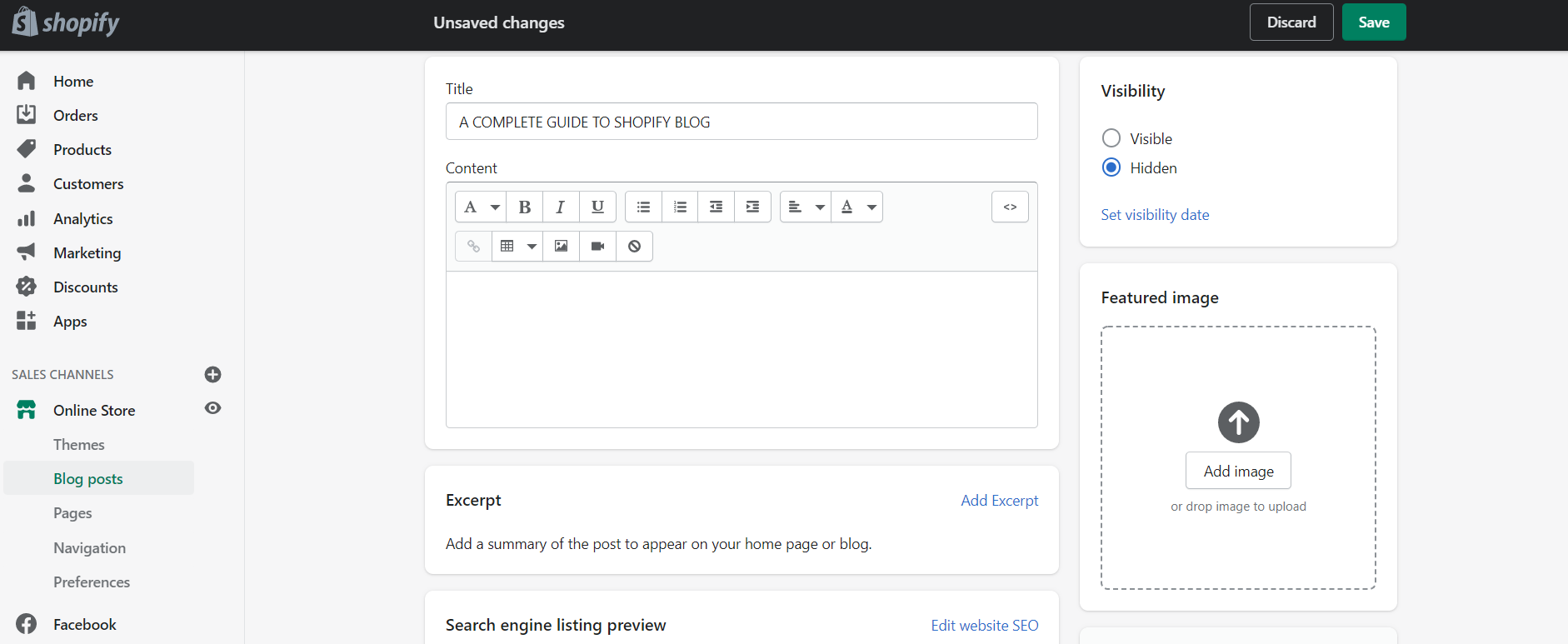
Start writing your Shopify Blog posts, and remember to click Save
5. After completing your blog, click on Save.
That’s it! You have improved your Shopify store with a blog section and post. You can now start frequently creating and publishing blog posts on your Shopify blog.
Step 4: Plan your publishing strategy
Just knowing how to create a Shopify blog post is not enough. You must also decide what kind of content you will create, how often you publish, and how to optimize content.
Planning your publishing strategy is important because it helps you:
- Create content that rocks: By planning ahead, you can research your topics, outline your posts, write eye-catching headlines, edit and proofread your content, and add images and videos that pop.
- Publish content that sticks: Remember to set a schedule. You can publish content on a regular basis, which helps you build trust and loyalty with your audience, boost your SEO ranking, and increase your traffic.
- Optimize content that ranks: By following best practices, you can optimize your content for search engines, which helps you rank higher on Google, drive more organic traffic, and generate more leads and sales.
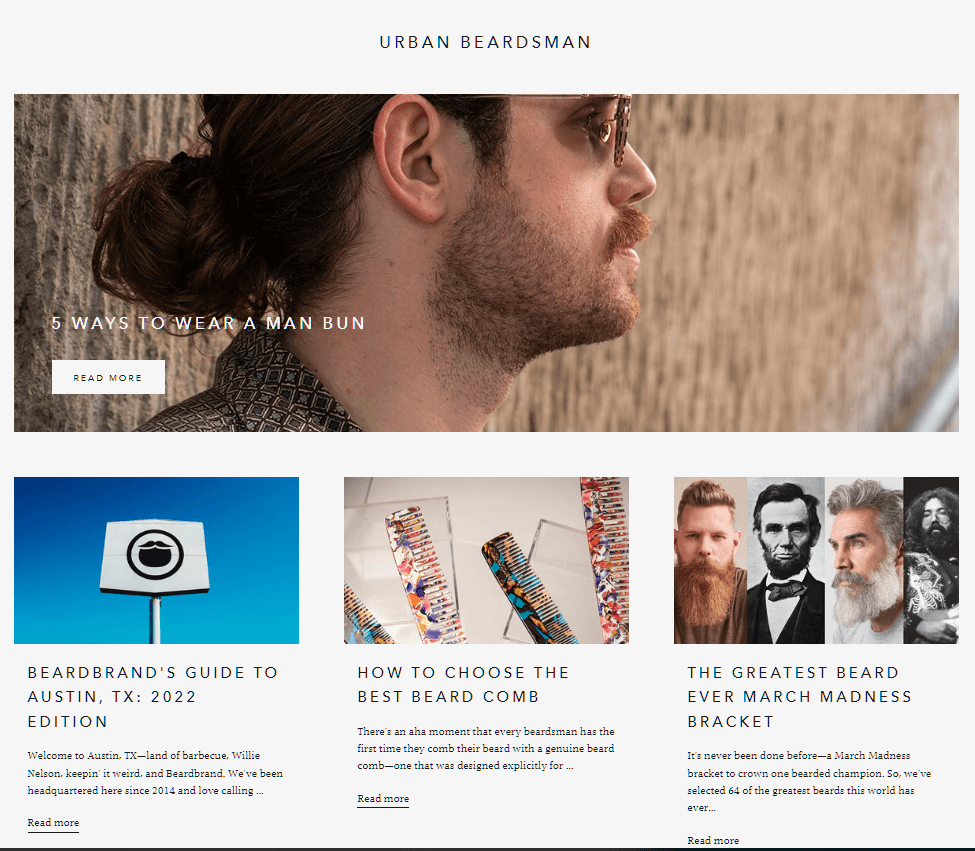
An example of a well-planned Shopify blog
But how do you plan your publishing strategy? Here are some tips:
- Choose the type of content that suits you: Choose the type that suits your niche, audience, and goals. For example, you can create video tutorials to teach your readers how to use your products.
- Choose the topic of content that matters: Make sure the content matters to the readers. Choose what’s relevant to your niche, audience, and products. For example, you can write about pet care tips, reviews, training guides, or stories if you sell pet products.
- Choose the keyword of content that works: Find the keyword from content that is popular, profitable, and low-competition. For example, if you sell dog collars, you can use keywords like “best dog collars”, “how to choose a dog collar”, or “dog collar size guide”.
- Choose the frequency of content that fits: You can choose the frequency of realistic, consistent, and optimal content. For example, you can publish new content daily with enough time and resources. If not, you can publish new content once a week or once a month. The key is to stick to your schedule and not disappoint your readers.
- Choose the length of content that satisfies: The length of content is also crucial. Make sure that it is sufficient, comprehensive, and engaging. For example, if you want to cover a topic in-depth and provide value to your readers, you can write long-form content over 3,000 words. If not, you can write short-form content that is under 1,000 words. The key is to avoid fluff and filler and keep your readers interested.
Step 5: Get loyal readers to your blogs
You might think that getting more people to read your blog is something you do after you publish it. But to start a blog that grows fast, you must have a plan before launching.
A lot of bloggers have trouble getting their blogs out there for two main reasons:
- They don’t have a clear and consistent way of spreading the word about their new posts.
- They feel nervous about sharing their blog and exposing themselves to feedback.
You’ll get over the second one with time, but the first one needs some upfront thinking and effort before you launch.
So let’s look at 5 ways you can prepare for growth and make the most of every blog post you create:
5.1. Start building your email list right away
No matter what platform you’re blogging on, you should focus on building email subscribers for your email marketing strategies and practices. Every new subscriber is a sign that you’re doing right and are a potential fan who will come back for more.
Even if you switch platforms later or start something new, your email list stays with you. But it’s not enough to just have a list. You need to get those emails at every opportunity and do that with contact forms.
A good tip is to put contact forms directly into your content or homepage with a catchy call to action to subscribe. You can even put one in a pop-up that shows up when someone is about to leave your site.
Many email marketing tools let you create and use these forms easily. You can also create a link that goes to a separate contact page that you can link to in your blog posts, social media, and email signature. If you are wondering which email marketing tools to choose, check out our top apps in this article.
Remember that people won’t subscribe to your blog if you don’t ask them and if you don’t make it easy for them. Every time you publish a new post, you should email it to your list—a process you can automate later once you get the hang of it.
5.2. Find out what topics people are searching for
Keyword research is finding the words or phrases your potential customers search for on Google or other search engines. Using keyword research, you can find out how many people are looking for certain topics in your blog niche. The higher the number, the more popular the topic and the more traffic you can get in the long run.
You can use tools like Google Keyword Planner, Ubersuggest, or Ahrefs to do keyword research for your niche and audience. Additionally, tools like AnswerThePublic, Quora, or Reddit can help you find questions and topics that your audience is interested in.
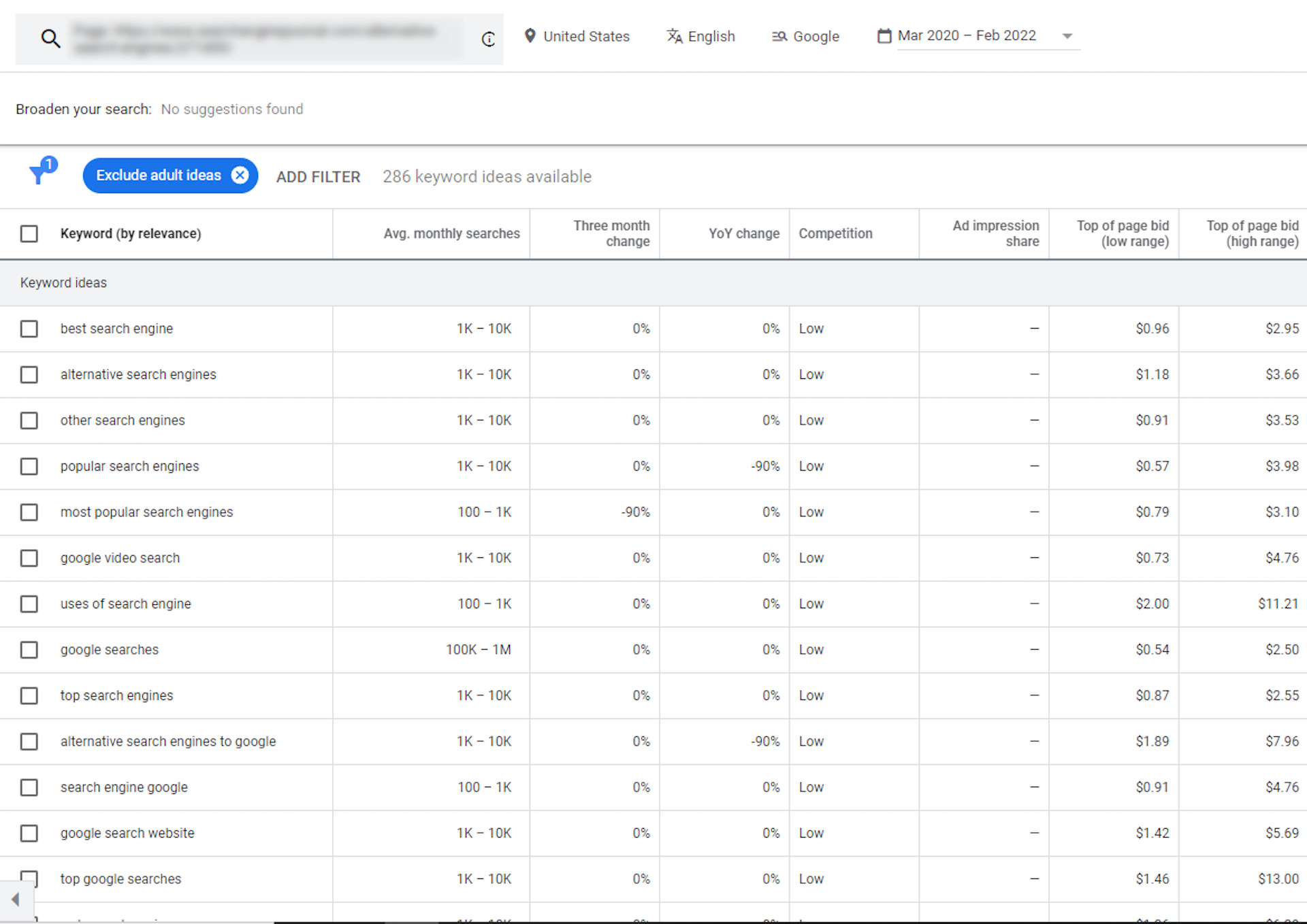
Tools like Google Keyword Planner can help you find topics for your Shopify blog
Even if you don’t rank on the first page of Google, you’ll have a content idea that people want to read. But if you want to aim high, you can learn more about SEO. And if you’re on Shopify, check out the free SEO checker app for making each blog post better.
5.3. Choose your social media channels wisely
While promoting your new blog on every social media platform might seem like a good idea, this can be hard to manage and ineffective. Instead, focus on the channels where your audience hangs out the most.
Do they join specific groups or forums? Are they on TikTok or Facebook? Your channel choice will vary depending on your niche and your resources.
To set up a social media strategy, you need to:
- Choose the right platforms: There are many social media platforms out there. You don’t need to be on all of them. You just need to choose the ones relevant to your niche, audience, and goals.
- Create a content calendar: A content calendar is a plan of what content you will create and share on social media. It is also a helpful tool for you to post content at the best time on different channels. You can use a content calendar to schedule your posts in advance, keep track of important dates and events, and ensure consistency and quality.
- Engage with your followers: Engagement is interacting with your followers on social media. Engage with your followers by responding to their comments and messages, asking them questions and feedback, or running contests and giveaways. Moreover, monitor your engagement rate to see which content is effective.
Don’t forget about your personal networks either—your friends and family are a great early audience as you start a blog!
5.4. Get more out of your content
You can’t write a long and original blog post every day. A smart blogger knows how to recycle and reuse their content to get more from it.
When time is precious, and you’re blogging for business, you must constantly get more value from your work. To reduce, reuse, and resurface your content, you need to:
- Reduce your content creation: Instead of creating new content all the time, you can focus on creating evergreen content that is relevant and valuable for a long time. Evergreen content doesn’t go out of date or lose its appeal.
- Reuse your content: Instead of creating different content for different platforms, you can reuse and repurpose your existing content for different formats and mediums. Repurposing content is transforming your content into something new and fresh.
- Resurface your content: Instead of letting your old content gets buried in the archives, you can resurface it and bring it back to your audience’s attention. Resurfacing content is the process of updating and promoting your old content.
5.5. Learn from analytics to learn from your audience
The best opportunities are hidden in your data, waiting for you to find them.
When you’re using the Shopify platform, take the time to set up Google Analytics on your Shopify site (it’s free!). With a Google Analytics account, you can get more insights on your new blog, like how long people read your posts and how good the readers are from different sources. You can even know how many readers you have right now!
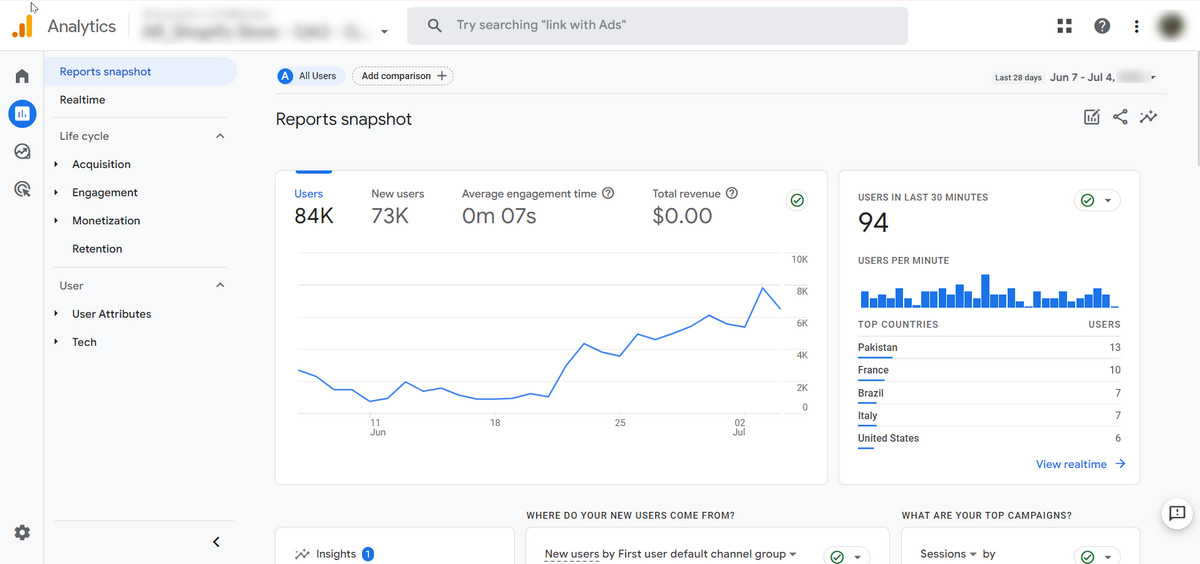
Google Analytics can greatly help you with Shopify blog
By understanding analytics to understand your audience, you can get people to read your blog consistently and increase your traffic, leads, and sales.
| 💡 Don’t know how to add Google Analytics to Shopify? Check out How To Add Google Analytics 4 To Shopify (3 Easy Steps)! |
Final Words
You’ve just learned how to start a Shopify blog with zero bucks as a newbie. You’ve discovered the secrets of finding a profitable niche, creating awesome content, and getting tons of traffic. You’ve also learned to use analytics to understand your audience and improve your blog.
Now you’re ready to take your eCommerce business to the next level with your Shopify blog. But don’t stop here. There’s so much more you can do to grow your blog and your store.
So what are you waiting for? Start your Shopify blog today and join the successful Shopify bloggers making money online. You won’t regret it!
